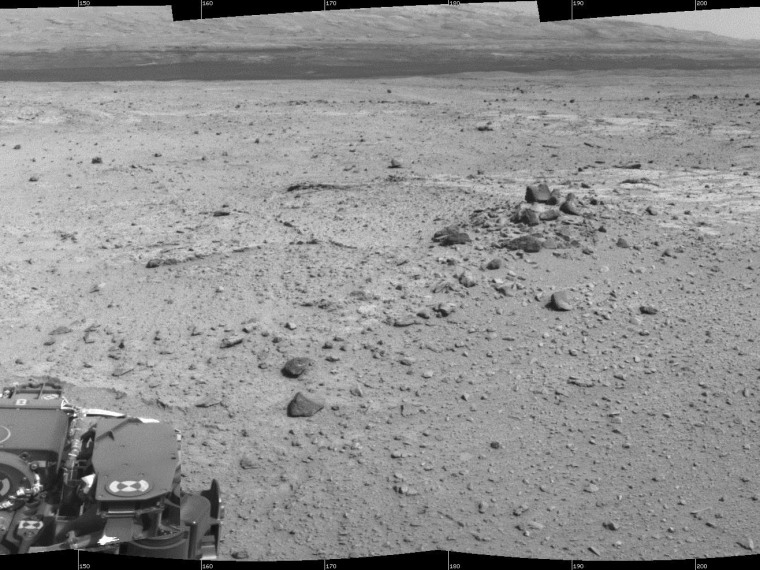For the first time, NASA's Curiosity rover on Tuesday drove itself through a stretch of Martian terrain that its handlers back on Earth couldn't see. It made it to the other side of a dip in the road just fine.
"It did skirt a little to the side," Mark Maimone, a rover mobility engineer and rover driver at NASA's Jet Propulsion Laboratory, told NBC News. "It sort of did an S curve."
The 33-foot (10-meter) drive marked the first time that the six-wheeled, nuclear-powered rover used its autonomous navigation software to travel along a path that could not be confirmed safe before the start of the drive. The maneuver followed up on a preparatory test last week, during which Curiosity plotted its own course but stayed within an area that operators had identified as safe.
This type of autonomous driving capability was used by NASA's Opportunity rover, which landed on Mars in 2004 and is still going strong. But Maimone said Curiosity has a much more robust ability to navigate on its own, thanks to an onboard computer that can process four times as much stereo data as Opportunity can.
"Curiosity takes several sets of stereo pairs of images, and the rover's computer processes that information to map any geometric hazard or rough terrain," Maimone explained in a JPL news release. "The rover considers all the paths it could take to get to the designated endpoint for the drive and chooses the best one."
Driving through a dip
On Tuesday, the rover was told to drive across a depression with a topography that couldn't be fully charted based on imagery from the previous day's drive. The 33-foot hidden stretch was part of a total driving distance of 141 feet (43 meters) for the entire Martian day, also known as a "sol."
"We could see the area before the dip, and we told the rover where to drive on that part," said rover driver John Wright. "We could see the ground on the other side, where we designated a point for the rover to end the drive, but Curiosity figured out for herself how to drive the uncharted part in between."
Maimone said Curiosity hadn't yet finished transmitting all the data from its drive, so he couldn't say why the rover took a slightly circuitous course. But he surmised that the rover saw a feature in the depression that it decided to skirt.
Curiosity is on its way to a 3-mile-high (5-kilometer-high) mountain in the middle of Gale Crater known as Mount Sharp or Aeolis Mons. The layers of rock on the mountainside may contain a record of Martian geochemical history going back billions of years — which makes it the $2.5 billion mission's prime target.
The latest drive left Curiosity about 4.46 miles (7.18 kilometers) from the entry point to Mount Sharp, based on a trajectory charted from orbit using imagery from NASA's Mars Reconnaissance Orbiter.
Stopping for science
The rover's science team has picked out several waypoints along the route where Curiosity may stop for science. Curiosity is currently about a third of a mile (500 meters) away from the first waypoint, where the imagery from the orbiter's HiRISE camera suggests there's an exposed stretch of bedrock.
"Each waypoint represents an opportunity for Curiosity to pause during its long journey to Mount Sharp and study features of local interest," said Caltech's John Grotzinger, the mission's project scientist. "These features are geologically interesting, based on HiRISE images, and they lie very close to the path that provides the most expeditious route to the base of Mount Sharp. We'll study each for several sols, perhaps selecting one for drilling if it looks sufficiently interesting."
Maimone said Curiosity's autonomous driving capability should give mission managers the leeway to extend the rover's driving distance as much as 330 feet (100 meters) per sol. On one occasion, that rover drove 400 meters by itself over a three-day weekend, Maimone said. Someday, Curiosity could take on similar solo treks.
"We could let it drive into the unknown, over as many days as we're willing to let it go," Maimone said.
More about Mars:
Alan Boyle is NBCNews.com's science editor. Connect with the Cosmic Log community by "liking" the NBC News Science Facebook page, following @b0yle on Twitter and adding the Cosmic Log page to your Google+ presence. To keep up with NBCNews.com's stories about science and space, sign up for the Tech & Science newsletter, delivered to your email in-box every weekday. You can also check out "The Case for Pluto," my book about the controversial dwarf planet and the search for new worlds.
